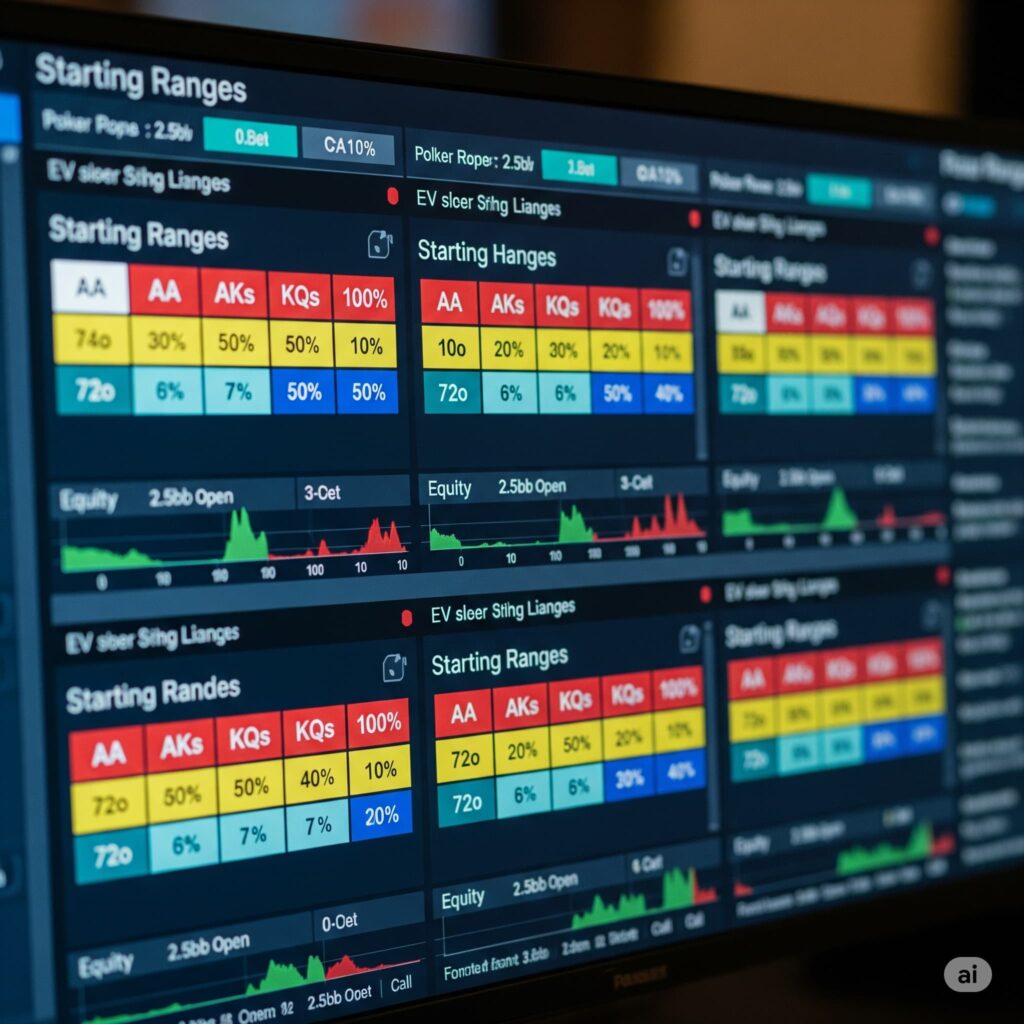Mastering poker strategy requires a deep understanding of how to construct effective hand ranges. Building a well-thought-out range is fundamental to making profitable decisions, whether you’re taking control of the pot or defending against an opponent’s aggression.
At its core, range construction is divided into two main categories:
aggressive ranges for when you’re betting or raising, and defensive ranges for when you’re facing a bet. Understanding the strategic goals behind each is the key to improving your game.

Aggressive Ranges: Maximizing Value
The main objective of an aggressive range is to
get the maximum payoff for your value hands across all possible board runouts. This means knowing which hands are strong enough to bet for value and how much you can expect an opponent to pay you off. There are three basic types of aggressive ranges: polar, merged, and linear.
Polar Ranges
A polarized range gets its expected value (EV) from two distinct places:
value betting (to get called by worse hands) and bluffing (to make better hands fold). This strategy is most clearly seen on the river.
- River Construction: Building a polar range on the river is straightforward.
- Value Hands: Your value betting range starts with hands you expect to be called by worse hands more often than better ones. For instance, a GTO solver might determine that any hand Queen-8 or better is strong enough for an all-in value bet.
- Bluffs: Your bluffs should be hands with very little or no showdown equity. You want to avoid turning a hand that could win at showdown into a bluff that might just break even. The best bluffing candidates are hands that block your opponent’s calling range. An example showed hands with 6% equity or less were bluffed 100% of the time.
- Earlier Streets & Pre-flop: True polar ranges are less common on the flop and turn because you need to consider how your range interacts with future cards. Pre-flop polar ranges typically appear in situations like 4-bet or 5-bet scenarios where post-flop play is unlikely. These ranges are often heavily focused on blockers, using hands with Aces and Kings.
Merged Ranges
Merged ranges are common on earlier streets and draw EV from multiple sources. They are composed of strong value hands, thinner value hands, various draws, and some weaker bluffs. These ranges are also built to ensure you have good
board coverage on future streets and to deny your opponents equity.
A
linear range is a type of merged range that includes top and middle-strength hands but excludes definitive bluffs.
- Flop Construction: You typically use a merged betting range on the flop when you aren’t betting with your entire range of hands and are using a standard bet size (e.g., 2/3 pot). The simplest way to think about constructing a merged range is that you bet at least some hands from every category. You’ll bet most of your strongest hands, check most of your middle-strength hands, and bet many of your weaker hands, creating a “V-shape” frequency distribution. This ensures your range is balanced and covers various board runouts.
Defensive Ranges: Realizing Your Equity
The goal of a defensive range is to
maximize the equity of hands that are too strong to fold but not strong enough to play aggressively. These ranges help you continue in a hand without bloating the pot unnecessarily. The two main types are linear and condensed.
Linear Defensive Ranges
A linear defensive range appears when your strategy only gives you one option to continue, such as “3-bet or fold” or “call or fold”. Construction is simple: you start with your strongest hands and continue down in strength until a hand is no longer profitable to play, at which point you fold the rest.
For example, a small blind facing a button open might play a “3-bet or fold” strategy, creating a purely linear continuing range.
Condensed Defensive Ranges
Condensed ranges are more complex and are used alongside a polar aggressive range. This range consists of medium-strength hands that you play passively by calling.
- Construction & Protection: A crucial aspect of a condensed calling range is protection. While you’ll raise your strongest hands most of the time, you should slow play by just calling with a small portion of them. This tactic protects your entire calling range, prevents it from being capped (meaning it doesn’t contain the strongest hands), and provides board coverage on later streets.
- Pre-flop Example: In a tournament with 40 big blind stacks, a big blind might use a polar 3-betting strategy (bluffing with hands that have good blockers) alongside a condensed calling range. In this scenario, premium pairs like Aces and Kings are almost always 3-bet or shoved, not slow-played.
- Flop Example: When facing a bet on a King-Jack-Four flop, a condensed calling range would primarily consist of middling equity hands. Top pairs will often call, and to protect the range, some two-pair combinations might also be included in the calling range instead of being raised. The EV of this condensed range is heavily supported by the aggressive, polar raising range that accompanies it.
Master Your Ranges
Building these strategic ranges can be difficult to implement perfectly without practice. To truly transform your approach, it’s highly recommended to use tools like the
Rangebuilder on GTOWizard AI. Spending time practicing the construction of polar, merged, and condensed ranges will elevate your strategic thinking and execution at the tables. Sources
